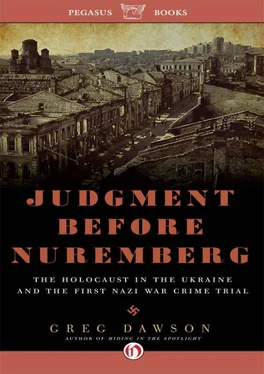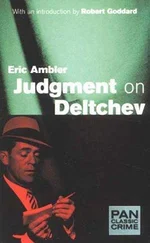Retzlaff:We were told that the Soviet people as one of the inferior races must be exterminated.
Prosecution:Thus, in the battalion you were taught methods of extermination of the Soviet people?
Retzlaff:Yes.
Prosecution:Was this policy ordered by the German government?
Retzlaff:Yes. In the course of a number of years the German government impressed this policy upon German minds through press, cinema, and radio.
Prosecution:Thus you were trained in this battalion not as officials but as hangmen?
Retzlaff:Yes, one may say so, as I later saw in practice.
Prosecution:How many Soviet citizens were exterminated by means of the gas van with your direct participation?
Retzlaff:I personally took part twice in loading people into the gas van. I put there about twenty persons each time.
Prosecution:How were the people murdered in the gas van buried?
Retzlaff:The bodies of the murdered people were buried in a gully to the south of Kharkov or burned.
Prosecution:They were burned?
Retzlaff:I was ordered to accompany a gas van to the area of the barracks of the Kharkov Tractor Plant. The gas van drew up in front of a gray-painted barrack. The S.D. men jumped out of their car and began to unload the bodies of the murdered people from the gas van and carried them into this barrack. When I entered, I saw the rooms on the right and left of the corridor were already packed with bodies which had apparently been brought there earlier.
Prosecution:Approximately how many bodies were there in the barrack together with those you had brought?
Retzlaff:There were approximately 300 to 350.
Prosecution:Continue your testimony.
Retzlaff:When the bodies had been stacked in the corridor, the S.D. men entered the barrack and poured petrol over them. They also poured petrol over the outside wall of the barrack. Then the S.D. men flung blazing torches inside and set fire to it. I saw six other barracks burnt down in the same manner.
Prosecution:What was the purpose of burning the bodies of people finished off in the gas van?
Retzlaff:So that the use of the gas van should be kept secret, and therefore traces of its work—dead bodies—were to be burnt.
Retzlaff told the court how he was schooled in a special brand of torture by a commissar of the 560th Group of the Secret Field Police at Kharkov. It happened during interrogation of two arrested workers.
Retzlaff:Karchan warned me that it was necessary to convict them of guerilla activities and obtain from them information about their accomplices. During the interrogation… I got the impression that these persons were not guilty and I reported this to Karchan. He asked me whether I resorted to beatings. I replied in the negative. Karchan then ordered me to beat up the prisoners.
Prosecution:Relate in detail how you carried out Karchan’s order.
Retzlaff:I borrowed a rubber truncheon from Sergeant-major Tichner which he usually used at interrogations. I failed to achieve anything by this means and reported this to Police Commissar Meliss, who then came to the office in which I examined the prisoners. Meliss told me that in examinations one must display greater resourcefulness. Pointing at the prisoners, he said, “Look, this prisoner has a fine beard. Pluck out the hair from it and prick the other with a needle.” I obeyed this order too, but failed to obtain any result.
Prosecution:Tell us what happened to the workers whom you had examined.
Retzlaff:Police Commissar Karchan ordered me to obtain through the Kharkov Passport Bureau a list of workers of the Tractor Plant and to copy out fifteen names. I carried out this order and the next day handed him a list of fifteen workers. The two prisoners whom I had examined were asphyxiated in the gas van and the fifteen workers on my list were shot.
Prosecution:Do you remember the names of the two workers from the Kharkov Tractor Plant who were finished off in the gas van and those fifteen workers who were shot?
Retzlaff:No, I do not remember. During my work I had to deal with so many prisoners that I could not remember all these Russian names.
Not among them was Mikhail Petrovich Bulanov, a driver—or “chauffeur” as he sometimes said—for the Gestapo in Kharkov from October 1941 to February 1943. Ironically, less is known about the one Russian defendant than about the three Germans. Bulanov, 26, was born in 1917 in Kazakhstan, and was not a member of any political party. In testimony he alluded to being married. I found no other personal information about him.
In the transcripts and reporting of the trial, Bulanov emerges as a fearful, reticent cipher amid his more formidable, unabashed co-defendants (he “looked like a man in a waking dream,” in Stevens’ vivid phrase), a pawn of history who invites pity—until his heinous crimes as a paid accomplice are recalled.
Bulanov:Early in December 1941, on the orders of the Gestapo Chief, about nine hundred sick people undergoing treatment in Kharkov hospital were shot.
Prosecution:What was your part in this affair?
Bulanov:I was ordered to bring a three-ton truck to the hospital. When I arrived, nine more three-ton trucks had arrived besides mine.
Prosecution:How many trips did you make?
Bulanov:I made four trips during which I brought to the shooting site approximately 150 persons.
Prosecution:Tell the Court how this was done.
Bulanov:When I arrived at the hospital… Gestapo men began to lead out patients dressed only in their underwear and load them into the trucks. I drove the truck to the shooting site approximately four kilometers from the city. When we arrived, screams and sobs of patients who were already being shot filled the air. Some begged for mercy and fell down naked in the cold mud, but the Germans pushed them into the pits and shot them.
Prosecution:Tell the Court what you know about the shooting of children in the Children’s Hospital of Nizhne Chirskaya.
Bulanov:On August 25 and 26, 1942, I—together with chauffeur Blokhin—was ordered to get the trucks ready. We were ordered to drive them to Nizhne Chirskaya Children’s Hospital. Upon our arrival, Gestapo men began to lead the children out of the hospital and load them on the trucks. The children were ragged, and swollen from hunger. Many resisted and would not board the trucks. The Gestapo men assured them they were going to their uncles and aunts in Stalingrad. Some children yielded to persuasion and got on the trucks, while others resisted. The Gestapo men forcibly put them in and I was ordered to fasten the canvas at the back of the truck. Three to four kilometers from Nizhne Chirskaya, a pit had been prepared. Having reached the pit, I and other Gestapo men began to take the children toward the pit near which stood a Gestapo man, Alex. Point-blank he shot the children in the head with an automatic rifle and then pushed them into the pit. Seeing this, the children struggled and tried to break away, crying, “Uncle, I am afraid!” and “Uncle, I want to live, don’t shoot me!” and so on. But the Germans took no notice of this.
Prosecution:What was the age of these children?
Bulanov:They ranged in age from six to twelve years.
Читать дальше












